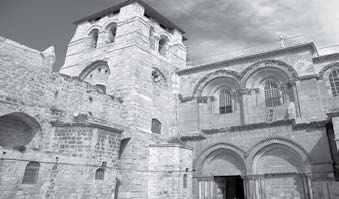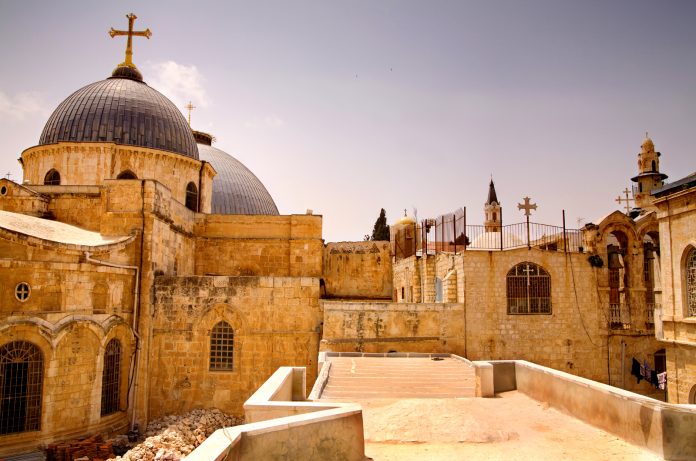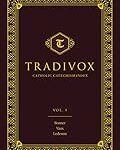College professors sometimes have too much time on their hands. While digging around in the crypt of an old medieval library in Oxford, I discovered an ancient forgotten manuscript. Here is what I can piece together. The document is a response drafted by Thomas Aquinas at the request of a Roman cardinal. The Vatican seems to have been embroiled in a conflict with powerful members of the Knights Templars over a building project to take place in Jerusalem, at the sight of the rock cave where Christ was buried. The Vatican lobbied for a Romanesque structure. The Grand Knight wanted a church in the style of the long suppressed “devotion moderna”—surprisingly like our own international modernism. Apparently, the Grand Knight defended his desire for a rupture from tradition because, as he claimed, “beauty is merely in the eye of the beholder.” From what the documents reveal, the cardinal used Thomas’ draft as the basis for his reply. The building under discussion is none other than the Church of the Holy Sepulchre, pictured below. As history attests, Thomas and the cardinal prevailed. Also depicted is an artist’s reconstruction of the Grand Knight’s counter proposal. Here is my translation of Thomas’ text. Read at your own risk. (Eat your heart out, Dan Brown.)

Objection 1. It would seem that beauty is subjective. For some men wear ties to Mass while others wear shorts. But both cannot be regarded as beautiful attire; therefore, beauty must be in the eye of the beholder.
Objection 2. Again, not only do judgments differ from man to man, they differ from age to age. For instance, Romanesque and Gothic builders magnify God through the use of proportion, symmetry, and explicit iconography that links a building to a tradition of worship: “Devotio moderna” builders, by contrast, wish to avoid all references to the past, use industrial materials, and aim for a building that is comfortable and inclusive. Therefore, as trends change, so must standards of beauty.
Objection 3. Further, sound judgment depends upon the use of right method (as in the empirical sciences). But, since men’s judgments of beauty differ, there must be no method. Therefore, judgments of beauty remain a matter of opinion only, and the strongest personality on the building committee ought to decide.
On the contrary: Beauty is an objective quality manifest within things made well. As Scripture says, Wisdom “arranged all things by measure and number and weight” (Wis 11:20). And work done well is praiseworthy: “Blessed be the Lord … who put such a thing as this into the heart of the king, to beautify the house of the Lord which is in Jerusalem” (Ezra 7:27).
I answer that, Beauty is that which gives pleasure when seen. For beauty to be present, three elements must be present: wholeness (integritas), proportion (proportio), and radiance (claritas). By wholeness is meant the integrity or completeness of an object. Hence, a cat without a tail, like a church without transept, archways, icons, and other such elements, displeases. Proportion refers to the fitting arrangement among the parts. For this reason men find it painful to look at a hairless poodle or a church with a shinny bare facade. Finally, radiance refers to the distinctness of lines and intelligibility of form. Distinct images in stained-glass windows, for instance, please more than abstract images as they give the mind more to consider.
Reply to objection 1. Beauty is chiefly a quality of the object, though secondarily judged in relation to the object’s surroundings. Hence, while shorts may be beautiful near sand, they become hideous beside the tabernacle. Wings are flattering on birds, not buildings.
Reply to objection 2. Certainly, some men today prefer buildings of the new style. But the fact of diversity proves nothing, except diversity. In fact, differences of opinion about beauty are sometimes caused by corrupted sense or ignorance. By analogy, just because some men are colour blind or fail at sums, we do not conclude that all flowers are grey or that the sum of 2 and 2 is unknown. Manifestly, for most men, it is more pleasing to see a Romanesque or Gothic Cathedral than one built in the “devotio moderna” style. Men who build in the “devotio moderna” style—heeding neither reason nor tradition—need healing or education, or both.
Reply to objection 3. Every science or art has its own methods. Beauty is rooted in nature, but perfected by culture. Hence, though most principles of sacred architecture arise from nature and can be expressed through mathematical ratios, others derive from revelation or the Church’s own tradition. Hence, any new architectural forms ought to grow organically from past forms. Besides, the strongest are not always the wisest.

Photo credit: Matthew Siebert











